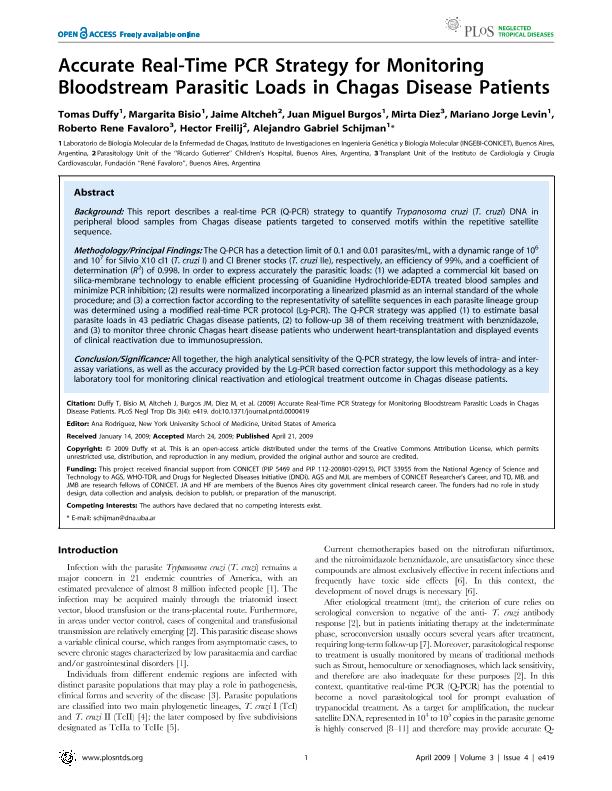Mostrar el registro sencillo del ítem
dc.contributor.author
Duffy, Tomás

dc.contributor.author
Bisio, Margarita María Catalina

dc.contributor.author
Altcheh, Jaime Marcelo

dc.contributor.author
Burgos, Juan Miguel

dc.contributor.author
Diez, Mirta
dc.contributor.author
Levin, Mariano Jorge

dc.contributor.author
Favaloro, Roberto Rene
dc.contributor.author
Freilij, Hector León

dc.contributor.author
Schijman, Alejandro Gabriel

dc.date.available
2019-07-16T17:22:05Z
dc.date.issued
2009-04
dc.identifier.citation
Duffy, Tomás; Bisio, Margarita María Catalina; Altcheh, Jaime Marcelo; Burgos, Juan Miguel; Diez, Mirta; et al.; Accurate real-time PCR strategy for monitoring bloodstream parasitic loads in chagas disease patients; Public Library of Science; PLoS Neglected Tropical Diseases; 3; 4; 4-2009; 419-429
dc.identifier.issn
1935-2735
dc.identifier.uri
http://hdl.handle.net/11336/79634
dc.description.abstract
Background: This report describes a real-time PCR (Q-PCR) strategy to quantify Trypanosoma cruzi (T. cruzi) DNA in peripheral blood samples from Chagas disease patients targeted to conserved motifs within the repetitive satellite sequence. Methodology/Principal Findings: The Q-PCR has a detection limit of 0.1 and 0.01 parasites/mL, with a dynamic range of 106 and 107 for Silvio X10 cl1 (T. cruzi I) and Cl Brener stocks (T. cruzi IIe), respectively, an efficiency of 99%, and a coefficient of determination (R2) of 0.998. In order to express accurately the parasitic loads: (1) we adapted a commercial kit based on silica-membrane technology to enable efficient processing of Guanidine Hydrochloride-EDTA treated blood samples and minimize PCR inhibition; (2) results were normalized incorporating a linearized plasmid as an internal standard of the whole procedure; and (3) a correction factor according to the representativity of satellite sequences in each parasite lineage group was determined using a modified real-time PCR protocol (Lg-PCR). The Q-PCR strategy was applied (1) to estimate basal parasite loads in 43 pediatric Chagas disease patients, (2) to follow-up 38 of them receiving treatment with benznidazole, and (3) to monitor three chronic Chagas heart disease patients who underwent heart-transplantation and displayed events of clinical reactivation due to immunosupression. Conclusion/Significance: All together, the high analytical sensitivity of the Q-PCR strategy, the low levels of intra- and interassay variations, as well as the accuracy provided by the Lg-PCR based correction factor support this methodology as a key laboratory tool for monitoring clinical reactivation and etiological treatment outcome in Chagas disease patients.
dc.format
application/pdf
dc.language.iso
eng
dc.publisher
Public Library of Science

dc.rights
info:eu-repo/semantics/openAccess
dc.rights.uri
https://creativecommons.org/licenses/by-nc-sa/2.5/ar/
dc.subject
Real Time Pcr
dc.subject
Parasitic Load
dc.subject
Trypanosoma Cruzi
dc.subject
Chagas Disease
dc.subject.classification
Otras Biotecnologías de la Salud

dc.subject.classification
Biotecnología de la Salud

dc.subject.classification
CIENCIAS MÉDICAS Y DE LA SALUD

dc.title
Accurate real-time PCR strategy for monitoring bloodstream parasitic loads in chagas disease patients
dc.type
info:eu-repo/semantics/article
dc.type
info:ar-repo/semantics/artículo
dc.type
info:eu-repo/semantics/publishedVersion
dc.date.updated
2019-07-12T17:38:03Z
dc.journal.volume
3
dc.journal.number
4
dc.journal.pagination
419-429
dc.journal.pais
Estados Unidos

dc.journal.ciudad
San Francisco
dc.description.fil
Fil: Duffy, Tomás. Consejo Nacional de Investigaciones Científicas y Técnicas. Instituto de Investigaciones en Ingeniería Genética y Biología Molecular "Dr. Héctor N. Torres"; Argentina
dc.description.fil
Fil: Bisio, Margarita María Catalina. Consejo Nacional de Investigaciones Científicas y Técnicas. Instituto de Investigaciones en Ingeniería Genética y Biología Molecular "Dr. Héctor N. Torres"; Argentina
dc.description.fil
Fil: Altcheh, Jaime Marcelo. Consejo Nacional de Investigaciones Científicas y Técnicas; Argentina. Gobierno de la Ciudad de Buenos Aires. Hospital General de Niños "Ricardo Gutiérrez"; Argentina
dc.description.fil
Fil: Burgos, Juan Miguel. Consejo Nacional de Investigaciones Científicas y Técnicas. Instituto de Investigaciones en Ingeniería Genética y Biología Molecular "Dr. Héctor N. Torres"; Argentina
dc.description.fil
Fil: Diez, Mirta. Fundación Favaloro; Argentina
dc.description.fil
Fil: Levin, Mariano Jorge. Consejo Nacional de Investigaciones Científicas y Técnicas. Instituto de Investigaciones en Ingeniería Genética y Biología Molecular "Dr. Héctor N. Torres"; Argentina
dc.description.fil
Fil: Favaloro, Roberto Rene. Fundación Favaloro; Argentina
dc.description.fil
Fil: Freilij, Hector León. Gobierno de la Ciudad de Buenos Aires. Hospital General de Niños "Ricardo Gutiérrez"; Argentina
dc.description.fil
Fil: Schijman, Alejandro Gabriel. Consejo Nacional de Investigaciones Científicas y Técnicas. Instituto de Investigaciones en Ingeniería Genética y Biología Molecular "Dr. Héctor N. Torres"; Argentina
dc.journal.title
PLoS Neglected Tropical Diseases

dc.relation.alternativeid
info:eu-repo/semantics/altIdentifier/url/https://www.ncbi.nlm.nih.gov/pmc/articles/PMC2667272/
dc.relation.alternativeid
info:eu-repo/semantics/altIdentifier/doi/http://dx.doi.org/10.1371/journal.pntd.0000419
dc.relation.alternativeid
info:eu-repo/semantics/altIdentifier/url/https://journals.plos.org/plosntds/article?id=10.1371/journal.pntd.0000419
Archivos asociados
